AMD AM1 Kabini Part 2: Athlon 5350/5150 and Sempron 3850/2650 Tested
by Ian Cutress on May 29, 2014 2:00 PM ESTCPU Synthetic Benchmarks
Content Creation - Cinebench
Based on MAXON’s CINEMA 4D animation software, Cinebench is used to determine the CPU and graphics performance via OpenGL. The software has gone through many iterations over the years, and here we use versions 10, 11.5 and 15 to compare single-threaded and multi-threaded CPU performance. As the generations increase, the software becomes more multithread aware and scales better, however for consistency with older results we keep the version 10 results in our database.
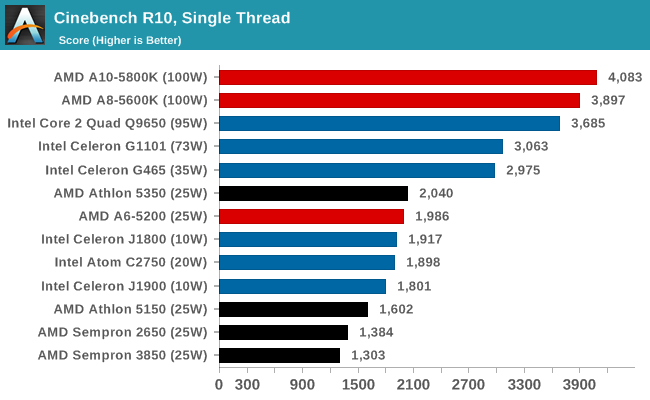
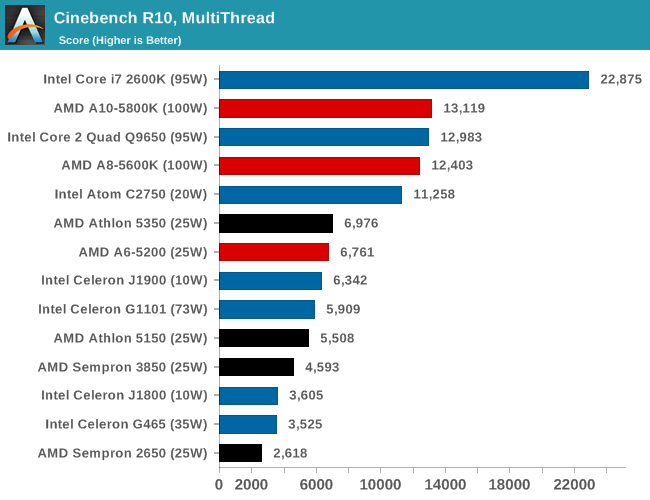
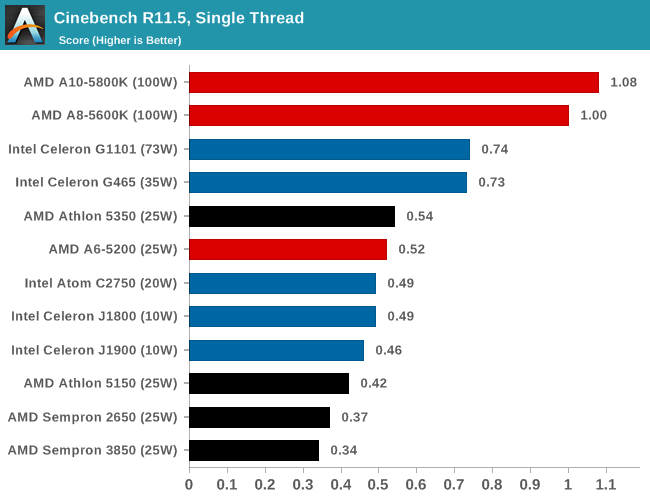
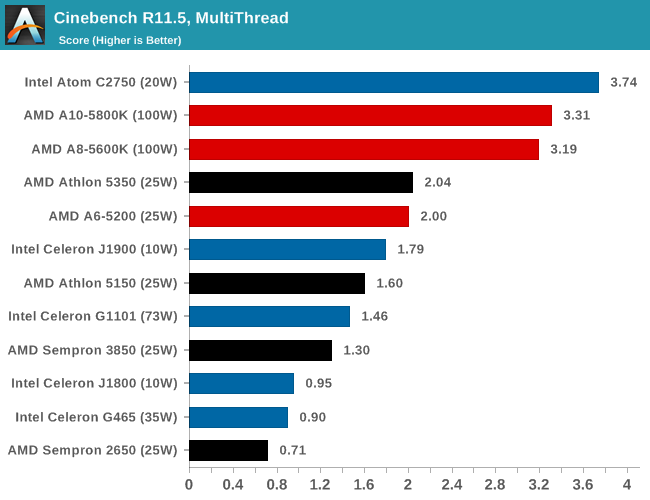
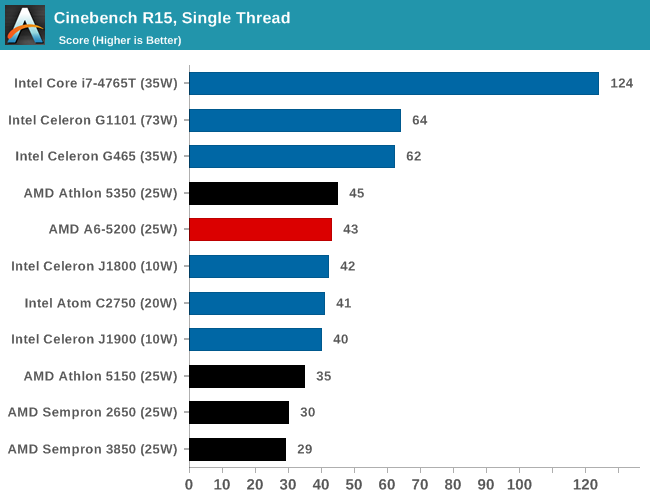
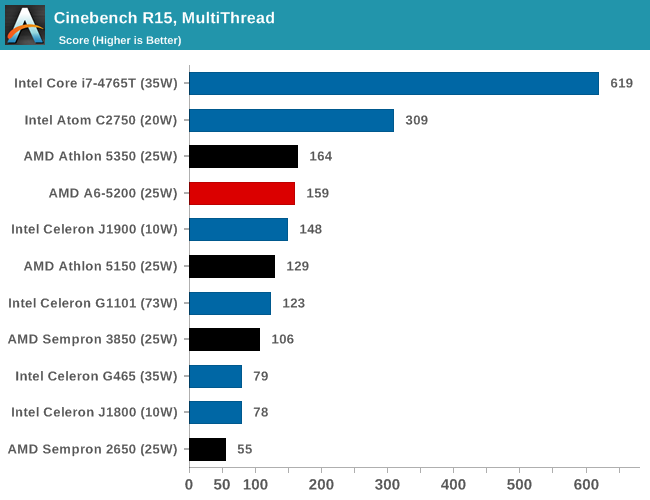
Synthetic – 7-Zip 9.2: link
As an open source compression tool, 7-Zip is a popular tool for making sets of files easier to handle and transfer. The software offers up its own benchmark, to which we report the result.
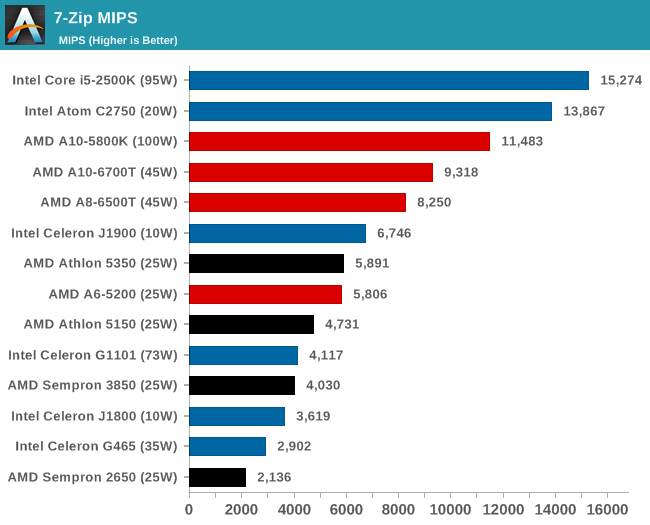
Rendering – PovRay 3.7: link
The Persistence of Vision RayTracer, or PovRay, is a freeware package for as the name suggests, ray tracing. It is a pure renderer, rather than modeling software, but the latest beta version contains a handy benchmark for stressing all processing threads on a platform. We have been using this test in motherboard reviews to test memory stability at various CPU speeds to good effect – if it passes the test, the IMC in the CPU is stable for a given CPU speed. As a CPU test, it runs for approximately 2-3 minutes on high end platforms.

Console Emulation –Dolphin Benchmark: link
At the start of 2014 I was emailed with a link to a new emulation benchmark based on the Dolphin Emulator. The issue with emulators tends to be two-fold: game licensing and raw CPU power required for the emulation. As a result, many emulators are often bound by single thread CPU performance, and general reports tended to suggest that Haswell provided a significant post to emulator performance. This benchmark runs a Wii program that raytraces a complex 3D scene inside the Dolphin Wii emulator. Performance on this benchmark is a good proxy of the speed of Dolphin CPU emulation, which is an intensive single core task using most aspects of a CPU. Results are given in minutes, where the Wii itself scores 17.53; meaning that anything scoring better than this is faster than an actual Wii for processing Wii code, albeit emulated.











87 Comments
View All Comments
Silver47 - Thursday, May 29, 2014 - link
They are in the graphs, what are you smoking?Novaguy - Thursday, May 29, 2014 - link
I think using a weaker card for the dgpu would also have been interesting. Maybe something like an r7 270, 7750 or 7770.Also, what about Mantle benchmarks?
Novaguy - Thursday, May 29, 2014 - link
I meant r7 250, not 270... can't seem to edit via mobile.V900 - Friday, May 30, 2014 - link
No, no Mantle benchmarks... It's useless, and only serves to clutter the article.Hardly anybody cared about Mantle when it was announced... And now that we know the next version of Direct X is coming, the only people that care the slightest, are a handful of AMD fanbois.
silverblue - Friday, May 30, 2014 - link
You're entitled to your opinion. Let's look at it this way - DirectX 12 won't be here for another 18 months. Also, Mantle has been shown to perform better than AMD's own implementation of DX11 (and sometimes faster than NV's as well) and also helps with lower performing CPUs.The following link only shows the one game, but it should be enough to highlight the potential benefit of Mantle on a comparatively weak architecture such as Jaguar:
http://www.pcper.com/reviews/Graphics-Cards/AMD-Ma...
If you didn't need to upgrade your CPU to play the latest and greatest, I think you'd care, too.
formulav8 - Friday, May 30, 2014 - link
If Mantle was from NVidia or Intel you would be a bigger stooge than anyone AMD.Gauner - Thursday, May 29, 2014 - link
I think it would be far more useful for this weak systems to have a different set of game tests.No one will buy one of those to play tomb raider or bioshock but I'm guessing some people would consider buying one if you could play for example league of legends or dota2 at minimum and 720/1080p.
I understand it would mean an extra effort but right now the gaming tests don't really tell anything useful nor do they add useful information to other reviews by having an extra comparison.
Just taking into account steam games(since they are the easier ones to get data about) in the top 5 most played games daily you always have: dota2, CS:GO and TF2. Those 3 games used to run(poorly, 800x600, low detail, 20-30fps) in the old Intel GMA4500M so in my opinion they have a lot of people potentially interested in them and would run well enough in low power systems to give a useful comparison between chips.
res057 - Thursday, May 29, 2014 - link
Tests with high end games and cpu intensive tasks for processors such as these is like Car and Driver putting a Prius through quarter-mile test and comparing the results with a Corvette. Pointless.Gauner - Friday, May 30, 2014 - link
I can understand the logic behind CPU intensive tasks, even if you wont use this kind of CPUs to compress video with x264 you can watch the results and get a realistic estimation on the performance difference because the test is the same for both weak CPUs and high end CPUs.Problem with the gaming tests is that the comparison is with settings completely different from the high end tests so no parallelism there and with a set of games that no one would think to play in weak systems so there is no useful info given.
I cant look at the results and say "since tomb raider at 1280x1024 with low graphics ran at 20fps I guess league of legends will run at 1080p with medium graphics and 35fps", there are too many different points to make a comparison(AAA engine vs engine designed for low power computers, different resolution, completely different poly count and texture sizes, ...).
takeship - Friday, May 30, 2014 - link
I'm curious why no comparison with the old E-450/E-2000 Jaguar chips. Not so much for the CPU performance, but for the GPU improvements going to GCN.